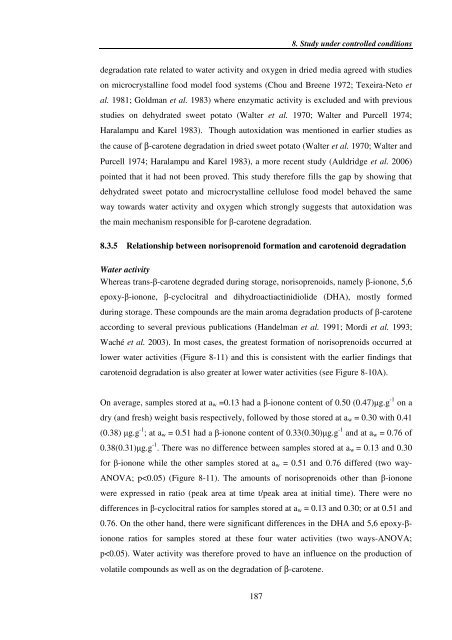Investigating carotenoid loss after drying and storage of
Investigating carotenoid loss after drying and storage of
Investigating carotenoid loss after drying and storage of
You also want an ePaper? Increase the reach of your titles
YUMPU automatically turns print PDFs into web optimized ePapers that Google loves.
187<br />
8. Study under controlled conditions<br />
degradation rate related to water activity <strong>and</strong> oxygen in dried media agreed with studies<br />
on microcrystalline food model food systems (Chou <strong>and</strong> Breene 1972; Texeira-Neto et<br />
al. 1981; Goldman et al. 1983) where enzymatic activity is excluded <strong>and</strong> with previous<br />
studies on dehydrated sweet potato (Walter et al. 1970; Walter <strong>and</strong> Purcell 1974;<br />
Haralampu <strong>and</strong> Karel 1983). Though autoxidation was mentioned in earlier studies as<br />
the cause <strong>of</strong> β-carotene degradation in dried sweet potato (Walter et al. 1970; Walter <strong>and</strong><br />
Purcell 1974; Haralampu <strong>and</strong> Karel 1983), a more recent study (Auldridge et al. 2006)<br />
pointed that it had not been proved. This study therefore fills the gap by showing that<br />
dehydrated sweet potato <strong>and</strong> microcrystalline cellulose food model behaved the same<br />
way towards water activity <strong>and</strong> oxygen which strongly suggests that autoxidation was<br />
the main mechanism responsible for !-carotene degradation.<br />
8.3.5 Relationship between norisoprenoid formation <strong>and</strong> <strong>carotenoid</strong> degradation<br />
Water activity<br />
Whereas trans-!-carotene degraded during <strong>storage</strong>, norisoprenoids, namely !-ionone, 5,6<br />
epoxy-!-ionone, !-cyclocitral <strong>and</strong> dihydroactiactinidiolide (DHA), mostly formed<br />
during <strong>storage</strong>. These compounds are the main aroma degradation products <strong>of</strong> !-carotene<br />
according to several previous publications (H<strong>and</strong>elman et al. 1991; Mordi et al. 1993;<br />
Waché et al. 2003). In most cases, the greatest formation <strong>of</strong> norisoprenoids occurred at<br />
lower water activities (Figure 8-11) <strong>and</strong> this is consistent with the earlier findings that<br />
<strong>carotenoid</strong> degradation is also greater at lower water activities (see Figure 8-10A).<br />
On average, samples stored at aw =0.13 had a !-ionone content <strong>of</strong> 0.50 (0.47)#g.g -1 on a<br />
dry (<strong>and</strong> fresh) weight basis respectively, followed by those stored at aw = 0.30 with 0.41<br />
(0.38) #g.g -1 ; at aw = 0.51 had a !-ionone content <strong>of</strong> 0.33(0.30)#g.g -1 <strong>and</strong> at aw = 0.76 <strong>of</strong><br />
0.38(0.31)#g.g -1 . There was no difference between samples stored at aw = 0.13 <strong>and</strong> 0.30<br />
for !-ionone while the other samples stored at aw = 0.51 <strong>and</strong> 0.76 differed (two way-<br />
ANOVA; p






